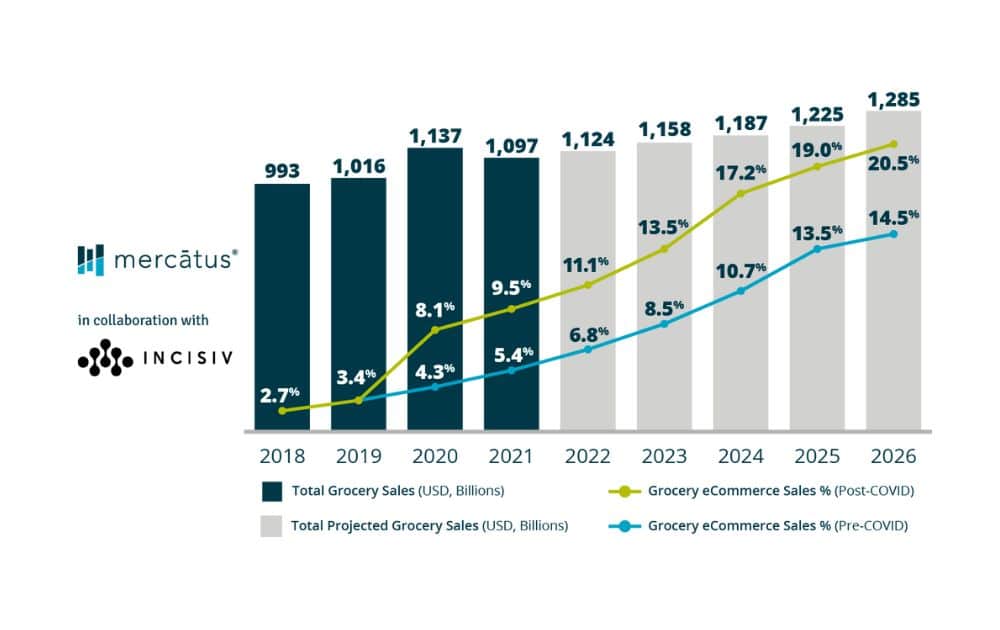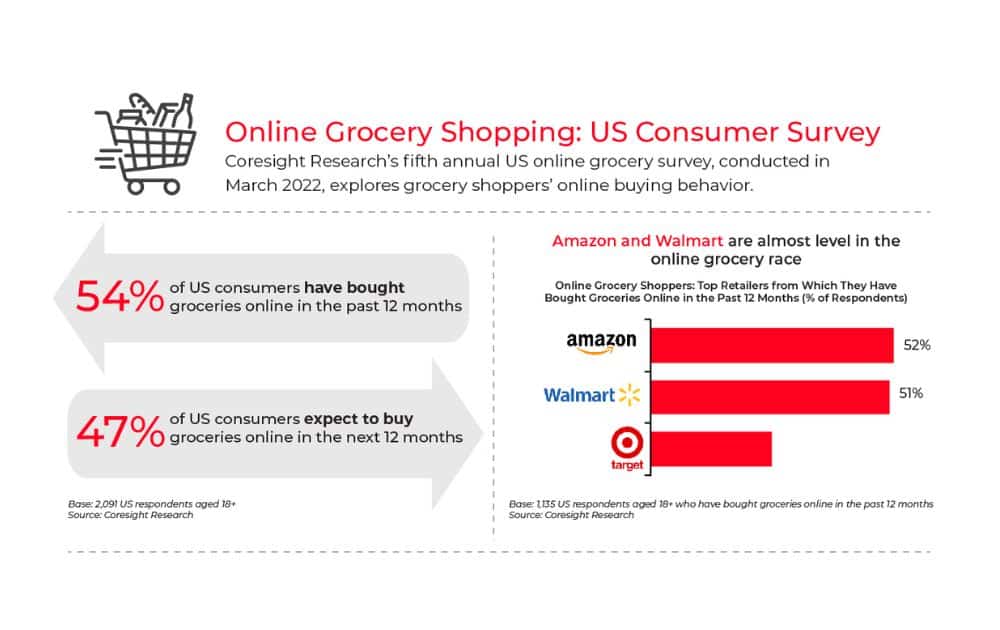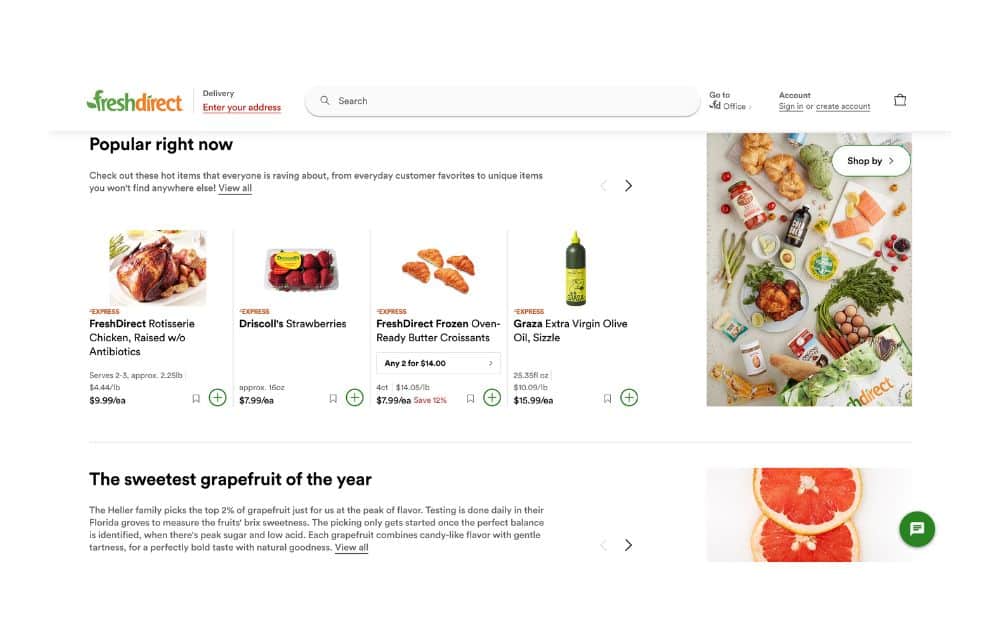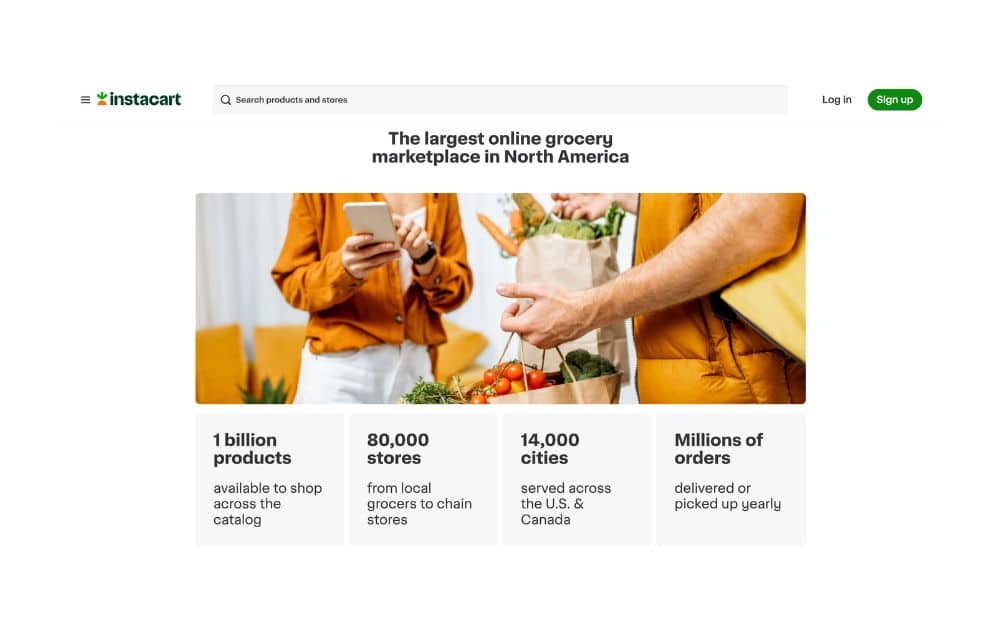
Grocery ecommerce isn’t just another trend; it’s a revolution quietly reshaping how we interact with one of our most fundamental needs: food.
Have you ever shopped for grocery items online? If your answer is yes, you’re not different from many consumers who turn to ecommerce for convenience.
If you’re looking for another online segment to tap, this article will serve as your map to navigating the bustling market of grocery ecommerce.
What is Grocery Ecommerce?
Grocery ecommerce refers to the buying and selling of food and grocery products through online platforms.
From fresh produce and pantry staples to organic products and specialty items, grocery ecommerce covers a wide range of consumables, making it a pivotal aspect of everyday life for consumers worldwide.
A study by Mercatus, in collaboration with Incisiv, revealed that online grocery sales are set to make up more than 20% of the total grocery market in the US by 2026.

The trend in consumer behavior toward online grocery shopping is also evident in the results of the US Online Grocery Survey 2022 by Coresight Research. Data says 54.3% of US adults engaged in online grocery shopping from 2021 to 2022, a notable rise from 36.9% in 2019.
Despite a slight decrease from the 59% participation rate in 2021, the figures clearly indicate a sustained shift towards digital grocery purchases among consumers.
The study also identified Amazon and Walmart as the top grocery ecommerce platform retailers patronized by respondents.

The above data proves the significance of grocery ecommerce. It represents a fusion of convenience and innovation, where the traditional chore of grocery shopping is transformed into a seamless, time-saving activity that can be conducted from anywhere, at any time.
For businesses, embracing grocery ecommerce opens up a new realm of opportunities—not only does it expand market reach, but it also provides invaluable insights into consumer preferences and behaviors.
Benefits of Grocery Ecommerce for Sellers
Here are a few benefits that grocery ecommerce offers sellers and why many entrepreneurs are looking to tap into this market:
Broader Market Access
You’ll have the ability to reach a wider audience without necessarily venturing into wholesale distribution.
Traditional brick-and-mortar stores are constrained by geographical location. In contrast, online platforms allow sellers to transcend physical boundaries, tapping into new customer segments and markets.
Operational Efficiency
Open up to a world of technologies, services, and strategies designed to streamline operations. From inventory management to order fulfillment, the digital infrastructure supports efficient business processes, reducing overhead costs and improving the bottom line.
Scalability
Online platforms, especially when paired with omnichannel eCommerce strategies, offer grocery ecommerce sellers the flexibility to scale their operations with relative ease.
As demand fluctuates or business objectives evolve, ecommerce facilitates the adjustment of inventory levels, expansion into new product lines, or scaling back operations without the significant financial risks associated with physical stores.
Customer Convenience
By providing customers the option to shop online, sellers enhance the shopping experience, offering convenience, speed, and a breadth of choice that traditional shopping methods can’t match. This level of service is critical in building a competitive edge in the retail landscape.
Sustainability
Ecommerce can also contribute to more sustainable business practices. By optimizing supply chains and reducing the need for physical retail space, online grocery businesses can lower their carbon footprint, appealing to environmentally conscious consumers.
How to Start Selling Groceries Online
Here’s a comprehensive guide on how to get your grocery ecommerce operation off the ground.
1. Choosing the Right Grocery Ecommerce Platform
When looking for a grocery ecommerce platform, prioritize features such as a user-friendly interface to ensure both you and your customers have a seamless experience. Integration capabilities are crucial for connecting with inventory management systems and marketing tools.
Opt for a platform that offers scalability to accommodate your business’s growth, and don’t overlook the importance of mobile optimization and robust security features to protect customer data.
If you’re selling grocery items through ecommerce platforms, you may want to do reverse sourcing to ensure that you’re offering in-demand items.
2. Setting Up Your Online Store
Start by registering a domain name that reflects your brand and is easy to remember. Design your store with either templates or custom designs to make it appealing and easy to navigate.
Having ineffective product pages is one of the eCommerce mistakes you would want to avoid. That said, it’s crucial to ensure that your product listings include high-quality images and detailed descriptions, as these can significantly enhance the shopping experience.
A straightforward checkout process and efficient search functionality are also vital for customer satisfaction.
3. Arranging Logistics and Fulfillment
Your fulfillment strategy should include options like local delivery services for same-day or next-day delivery, micro-fulfillment centers to reduce delivery times, and third-party logistics (3PL) providers to handle storage, packing, and shipping.
Efficient delivery and inventory management are crucial for grocery ecommerce growth. In addition, offering various delivery options can meet different customer preferences while optimizing delivery routes through data analytics can reduce shipping times.
Success Stories in Grocery Ecommerce
Case Study 1: The Rise of FreshDirect
FreshDirect, a pioneer in the digital grocery delivery service, has carved out a significant niche in the highly competitive US market. By prioritizing fresh, quality products and superior customer service, they’ve managed to build a loyal customer base.

- Challenges Overcome. One of the main hurdles FreshDirect faced was establishing a robust supply chain that could handle perishable goods efficiently. Investing in state-of-the-art cold storage facilities and developing strong relationships with local farmers and suppliers were key strategies they implemented.
- Lessons Learned. The FreshDirect story teaches the importance of quality and reliability in the grocery ecommerce space. They also highlight the necessity of a solid logistical framework to ensure product freshness upon delivery.
Case Study 2: Instacart’s Rapid Expansion
Instacart‘s business model, leveraging a network of personal shoppers to deliver groceries from existing supermarkets, has seen exponential growth. Their platform connects customers with freelancers who shop and deliver groceries on their behalf.

- Challenges Overcome. Instacart navigated the logistical complexities of coordinating between multiple supermarkets and delivery personnel. Implementing a dynamic pricing model and a user-friendly app were crucial steps in their strategy.
- Lessons Learned. Instacart’s success underscores the potential of a platform model in grocery ecommerce, emphasizing the value of convenience and speed. Their adaptability and focus on customer experience have been pivotal to their growth.
Driving Growth in Grocery Ecommerce
Here are some practical tips for sellers looking to make their mark in the online grocery space:
- Understand grocery ecommerce trends as well as your target market’s preferences and shopping habits. Tailoring your offerings to meet their needs can set you apart from competitors.
- With a significant portion of online shopping happening on mobile devices, ensuring your website and app are mobile-friendly is crucial for a seamless shopping experience.
- The quality of your produce can make or break your reputation. Implement strict quality control measures to ensure only the freshest products reach your customers.
- Use social media platforms to connect with your audience, promote deals, and provide customer service. It’s a powerful tool for building brand loyalty and attracting new customers.
- Flexibility in delivery options, including same-day delivery, scheduled slots, and click-and-collect services, can significantly enhance customer convenience.
- Customer reviews can greatly influence buying decisions. Encourage your customers to leave feedback and use it to improve your offerings and service.
- Optimize your website for search engines to increase visibility. Use relevant keywords, high-quality images, and meta descriptions to improve your search rankings.
Frequently Asked Questions (FAQs)
What is the Biggest Grocery Ecommerce?
When it comes to identifying the biggest grocery ecommerce platform, Amazon Fresh often comes to mind for many people.
Amazon Fresh has significantly expanded its reach and capabilities, offering a wide range of products from fresh produce to pantry staples, and benefiting from Amazon’s robust logistics network.
It’s important to note that while Amazon Fresh is a major player, other platforms like Walmart’s online grocery service and Instacart also hold significant shares of the market.
What Does Online Grocery Shopping Do?
Online grocery shopping revolutionizes the way consumers approach daily errands by bringing the supermarket right to their fingertips.
This service offers unparalleled convenience, allowing shoppers to place orders at any time of the day and schedule deliveries or pickups at times that fit their busy schedules.
It’s particularly beneficial for those with tight schedules, mobility issues, or anyone looking to save time for other activities.
How to Make Online Grocery?
Creating an online grocery platform begins with in-depth market research and developing a detailed business plan.
Establishing strong relationships with suppliers ensures a consistent supply of quality products, while choosing a robust ecommerce platform is essential.
The Lowdown
Grocery ecommerce is more than just a digital extension of the traditional grocery store. It’s a transformative platform that offers endless opportunities for growth, innovation, and connection with consumers.
Whether you’re a seasoned retailer or a new entrant, the time to embrace grocery ecommerce is now. With dedication, insight, and the right strategies, your online grocery business can flourish, meeting the needs of today’s digital-savvy shoppers.
Author
 Carla Bauto Deña is a journalist and content writer producing stories for traditional and digital media. She believes in empowering small businesses with the help of innovative solutions, such as e-commerce, digital marketing, and data analytics.
Carla Bauto Deña is a journalist and content writer producing stories for traditional and digital media. She believes in empowering small businesses with the help of innovative solutions, such as e-commerce, digital marketing, and data analytics.
Discover more from reviewer4you.com
Subscribe to get the latest posts to your email.





